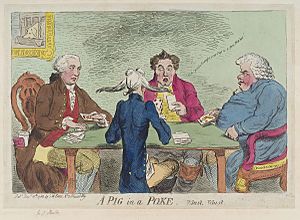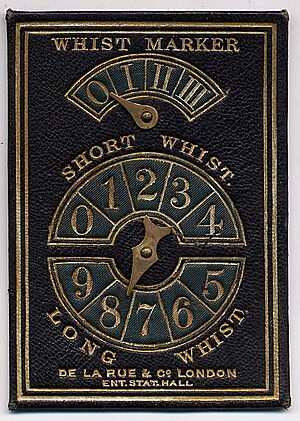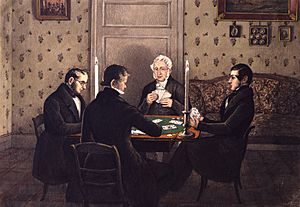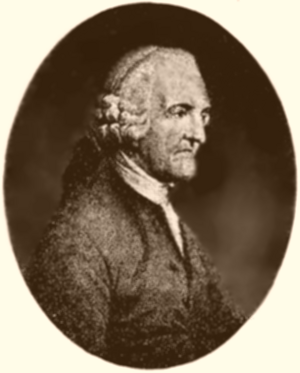Whist facts for kids


Whist is an old English card game that was very popular in the 1700s and 1800s. It's a game where players try to win "tricks" (groups of cards played in a round).
Four players play Whist. They form two teams, with partners sitting across from each other. To pick teams, players draw cards. The two players with the highest cards team up against the two with the lowest. Then, they decide who deals the cards. In Whist, you don't "bid" like in some other card games. A special card is chosen to be the "trump" suit. This makes Whist easy to learn!
Even though the rules are simple, you can use smart strategies. Long ago, people often played Whist for money in clubs and coffee shops.
Contents
History of Whist
Whist comes from an even older game called trump or ruff, which was played in the 1500s. The name "Whist" comes from a word in the 1600s that meant "quiet" or "attentive." This is also where the word "wistful" comes from today.
The first time Whist was written about was in a book called The Compleat Gamester by Charles Cotton in London in 1674. It also appeared in another book, Court Gamester, in 1719. We know people played Whist in London's coffee houses. Around 1728, a group led by Lord Folkestone started playing in Crown's coffee house. They helped make Whist a better game for teams.
Edmond Hoyle was a teacher who taught rich young men how to play Whist. In 1742, he wrote a book called A Short Treatise on the Game of Whist. This book became the main guide for the game for the next 100 years. It helped make Whist very popular. There are more than 150 different versions of this small book!
In the 1890s, a new version called bridge-whist became popular. This game slowly changed into auction bridge, and then into contract bridge in the late 1920s.
The original game of Whist is still played today at social events called whist drives.
How to Play and Behave
The rules tell you how to play the game. Etiquette is about how players should act during the game.
You use a standard deck of 52 cards. In each suit, the cards rank from highest to lowest: Ace, King, Queen, Jack, 10, 9, 8, 7, 6, 5, 4, 3, 2. Four players play Whist in two teams, with partners sitting opposite each other. Players draw cards to decide who their partners are. The two players with the highest cards play against the two with the lowest. Then, they draw cards again to see who deals first.
It is considered bad manners to talk about the cards you have. You should not complain about your hand or brag about good luck.
Smart Card Play
Many clever ideas in card games were first thought of by Whist players. These ideas are still used today in games like contract bridge.
One idea is called the finesse. This is when you try to win a trick with a card that isn't your highest. For example, if you have the Ace, Queen, 7, and 3 of a suit, but your team doesn't have the King. If your partner plays a low card, and the next player also plays low, you might play your Queen. If the Queen wins the trick, you've gained an extra trick!
Players also learned to send signals to their partners using the cards they played. For example, leading the top card from a sequence, like playing the King when you also have the Queen and Jack. Another signal is leading the fourth highest card from a suit. This often means you have one or two high cards in that suit. In 1834, Lord Henry Bentinck came up with the "high-low" signal. This signal encourages your partner to keep playing the same suit.
Some very advanced ideas were also known. Alexandre Deschapelles, a brilliant French player, invented a move called the Deschapelles coup. This is when you give up a high card on purpose to let your partner play their cards.
Duplicate Whist
The idea of having all players in the same position play the exact same cards was first used for Whist. In a duplicate whist game, teams are scored based on how well they play the same cards. Modern ways of running bridge tournaments came from this duplicate whist system.
John T. Mitchell, a man from Scotland who moved to the U.S., invented the basic system. In the 1890s, he created special boards to hold the cards. He also came up with the way players move around tables in whist drives. In the basic Mitchell movement, North/South teams stay put, while East/West teams move up one table each round. The card boards move down one table. This system allowed many teams to play the same sets of cards. This is how tournament Whist began. The idea, with some changes, is still used today for bridge tournaments.
Images for kids
-
19th-century whist counter depicting the departure of Cumberland Jack from Britain.
See also
 In Spanish: Whist para niños
In Spanish: Whist para niños





